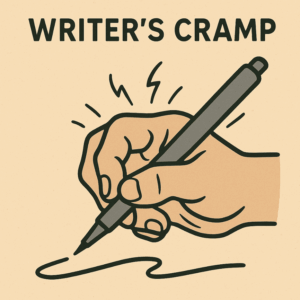Finding Relief in a Touch: Geste Antagoniste in Writer’s Cramp Management
 Introduction
Introduction
Imagine this—you sit down to write, and your hand just won’t cooperate. Your fingers curl, your wrist stiffens, and the pen slips. No matter how hard you try, writing becomes painful or impossible.
This isn’t just fatigue. It’s a condition known as writer’s cramp—a type of focal hand dystonia. While it may seem like a purely muscular issue, the problem actually lies deep in the brain’s motor circuits.
But here’s the fascinating part: many people with writer’s cramp discover that a simple touch—a light finger press on the back of the hand or wrist—can make the cramp vanish almost magically. This phenomenon is called a geste antagoniste, or sensory trick, and it opens a door to better, non-invasive management.
In this blog post, we’ll explore the science, types, and therapeutic uses of this trick.
What Is Writer’s Cramp?
Writer’s cramp is a task-specific dystonia, meaning the involuntary muscle contractions occur only during certain tasks—like writing. It’s often seen in professionals, students, or anyone who writes for prolonged periods.
Common symptoms:
-
Hand stiffness or cramping while writing
-
Fingers curling uncontrollably
-
Tremors or spasms in the hand
-
Inability to write in a straight line or hold a pen properly
It is not a psychological problem and is not due to muscle weakness. Instead, it’s related to abnormal brain signals controlling muscle movement.
The Geste Antagoniste: A Mysterious Touch
The word “geste antagoniste” (pronounced zjest an-ta-go-neest) comes from French, meaning “counteracting gesture.” It refers to a deliberate, usually light, sensory input that temporarily relieves the abnormal postures or movements of dystonia.
In writer’s cramp, it might be:
-
Lightly touching the back of the hand
-
Pressing the thumb against the index finger
-
Wearing a ring or bracelet
-
Holding an object in the opposite hand
Real-Life Example:
Ravi, a 34-year-old architect from Chennai, developed writer’s cramp during late-night project work. His hand cramped up every time he tried to sign documents. But he noticed that when he touched his wrist with his other hand, the cramp eased, and he could write smoothly for a few minutes. That was his geste antagoniste.
Common Locations of the Sensory Trick
Different people find different “sweet spots” where touch helps. Here are the most commonly reported locations:
| Location | Sensory Trick | Why It Might Help |
|---|---|---|
| Back of Hand | Lightly pressing or tapping while writing | Modifies sensory input to calm motor output |
| Thumb or Index Finger | Pressing fingers together | Improves precision and motor control |
| Wrist | Touching with other hand or wearing a band | Provides anchoring proprioceptive feedback |
| Forearm | Tapping or holding | Disrupts dystonic signal pathways |
| Opposite Hand | Holding an object or applying pressure | May divert brain’s attention or balance circuitry |
| Face or Chin | Touching cheek or jaw | Known to help in some facial dystonias and can overlap in focal hand cases |
How Does It Work?
While the exact mechanism isn’t fully understood, neuroscientists believe these gestures:
-
Alter abnormal sensorimotor integration in the brain
-
Temporarily normalize inhibitory brain circuits
-
Distract or reset motor pathways involved in dystonia
Think of it as a “neural circuit breaker” that can reset the overfiring motor circuits just long enough for the task to be done.
How Can You Use This Therapeutically?
1. Self-Discovery and Awareness
Encourage patients to explore what works:
-
Try light touch in different areas while writing
-
Use textured gloves or wearables
-
Note when the cramp reduces and what action helped
2. Incorporate into Occupational Therapy
Therapists can:
-
Help identify the gesture
-
Train consistent use
-
Combine with ergonomic aids like pen grips
3. Use in Clinical Assessment
The presence of a geste antagoniste helps confirm the diagnosis of a focal dystonia, differentiating it from other motor disorders.
4. Combine with Other Treatments
-
Botox injections remain the gold standard for reducing excessive muscle activity
-
Physical therapy, mirror therapy, or voice-to-text tools can supplement management
-
But sensory tricks can be a game-changer, especially in milder cases or where other treatments fail
Caution: Not a Cure, But a Clue
While the geste antagoniste doesn’t cure writer’s cramp, it gives us a window into the underlying neurology. For some, it may offer practical relief. For clinicians, it may help shape personalized, non-invasive treatment approaches.
Indian Context: Practical Tips
-
Use of regional scripts like Tamil or Hindi sometimes causes less cramp than English, possibly due to different hand movements.
-
Pen-friendly grips, Lamy-style pens, or local modifications (like sponge wraps) can help reinforce the sensory input.
-
Apps like Google Voice Typing in Tamil or regional languages can reduce writing strain.
Final Word: Gentle Touch, Powerful Relief
In a condition as frustrating as writer’s cramp, the answer sometimes lies in the simplest of gestures. The geste antagoniste teaches us the power of awareness, adaptation, and the brain’s amazing ability to reset itself—even with just a touch.
📍Need Help Managing Writer’s Cramp?
Dr. Srinivas Rajkumar T offers personalized evaluation and non-pharmacological solutions alongside conventional treatments for task-specific dystonias. Schedule a consultation at Apollo Clinic Velachery or Tambaram, or reach out via teleconsultation.
Dr. Srinivas Rajkumar T
Consultant Psychiatrist
Apollo Clinics – Velachery & Tambaram
📍 Chennai | 🌐 www.srinivasaiims.com | ☎️ 8595155808
Special interest: Psychoneurology, Movement Disorders, Cognitive Therapy